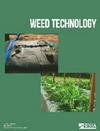种植绿色玉米时,谷黑麦残留管理策略对玉米行间和行内杂草补充动态的影响
IF 1.7
3区 农林科学
Q3 AGRONOMY
引用次数: 0
摘要
将覆盖作物的终止推迟到经济作物种植(即种植绿色作物)是一种新兴的免耕做法。在玉米生产系统中种植绿色作物时,需要改进管理建议,以优化杂草抑制效益,同时最大限度地减少其他害虫、肥力和作物管理风险。在一项为期两年的田间试验中,我们评估了与标准终止(种植前14天;14DPP)和黑麦收获(14DPP。在一项为期两年的田间试验中,我们评估了玉米对相同残留物管理策略的反应。在站点实验中,不同年份的谷物-黑麦生物量产量差异显著,2020年和2021年分别观察到平均水平(4.9 Mg ha-1)和异常水平(9.9 Mg ha-2)。2020年,与在直立谷物黑麦中种植绿色作物相比,使用集成卷边机/行清洁器系统种植绿色作物可提高行内杂草密度。与提前终止(14DPP)相比,采用卷边时行间杂草密度较低。与其他处理相比,在直立的谷类黑麦中种植绿色导致更高的平均玉米高度(V5阶段),但玉米种群和产量没有差异。2021年,几乎没有观察到杂草补充模式的差异,但与提前终止相比,种植绿色处理的玉米种群和产量明显较低。多年来,与一次通过PRE项目相比,两次通过POST项目的晚季杂草生物量较低。田间试验表明,在残留的玉米渣中种植绿色可以增加玉米的高度,并减少玉米的数量,这可能导致产量下降。我们的研究结果表明,优化除草剂施用时间的管理建议应考虑与优化玉米性能所需的残留管理策略相关的行内和行间杂草补充动态。本文章由计算机程序翻译,如有差异,请以英文原文为准。
Cereal rye residue management tactics influence inter- and intra- row weed recruitment dynamics in field corn when planting green
Delaying cover crop termination until cash crop planting (i.e., planting green) is an emerging no-till practice. Improved management recommendations are needed for optimizing weed suppression benefits while minimizing other pest, fertility, and crop management risks when planting green in corn production systems. In a 2-yr field experiment, we evaluated the interaction between cereal rye residue management tactics (standing residue, roll-crimping, roll-crimping with row cleaners) and herbicide programs (1-pass PRE, 2-pass POST) when planting green on weed recruitment spatial patterns and corn performance compared to standard termination (14 d pre-plant; 14 DPP) and ryelage harvest (14 DPP) practices. In a 2-yr on-farm experiment, we evaluated corn performance in response to the same residue management tactics. Cereal rye biomass production varied significantly across years in on-station experiments, with average (4.9 Mg ha-1) and anomalous (9.9 Mg ha-1) levels observed in 2020 and 2021, respectively. In 2020, planting green with an integrated roll-crimper/row cleaner system resulted in greater intra-row weed density compared to planting green into standing cereal rye. Inter-row weed density was lower when employing roll-crimping compared to early-termination (14 DPP). Planting green into standing cereal rye resulted in greater mean corn height (V5 stage) compared to other treatments but corn population and yield did not differ. In 2021, few differences in weed recruitment patterns were observed, but corn population and yield were significantly lower in planting green treatments compared to early termination. Across years, late-season weed biomass was lower in two-pass POST programs compared to one-pass PRE programs. On-farm trials showed that planting green into standing residue increases corn height, and can reduce corn populations, which may lead to reduce yields. Our results suggest that management recommendations for optimizing herbicide application timing should consider intra- and inter-row weed recruitment dynamics associated with residue management tactics needed to optimize corn performance.
求助全文
通过发布文献求助,成功后即可免费获取论文全文。
去求助
来源期刊

Weed Technology
农林科学-农艺学
CiteScore
2.90
自引率
21.40%
发文量
89
审稿时长
12-24 weeks
期刊介绍:
Weed Technology publishes original research and scholarship in the form of peer-reviewed articles focused on understanding how weeds are managed.
The journal focuses on:
- Applied aspects concerning the management of weeds in agricultural systems
- Herbicides used to manage undesired vegetation, weed biology and control
- Weed/crop management systems
- Reports of new weed problems
-New technologies for weed management and special articles emphasizing technology transfer to improve weed control
-Articles dealing with plant growth regulators and management of undesired plant growth may also be accepted, provided there is clear relevance to weed science technology, e.g., turfgrass or woody plant management along rights-of-way, vegetation management in forest, aquatic, or other non-crop situations.
-Surveys, education, and extension topics related to weeds will also be considered
 求助内容:
求助内容: 应助结果提醒方式:
应助结果提醒方式:


